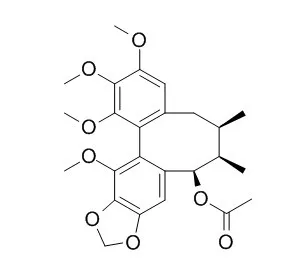| In vitro: |
| J Nat Prod. 2002 Sep;65(9):1242-5. | | Interiotherins C and D, two new lignans from Kadsura interior and antitumor-promoting effects of related neolignans on Epstein-Barr virus activation.[Pubmed: 12350139] |
METHODS AND RESULTS:
Two new lignans, interiotherins C (1) and D (2), together with the known compounds interiorin (3), heteroclitin F (4), neokadsuranin (5), heteroclitin D (6), Kadsurin (7), gomisin A (8), schisandrin C (9), interiotherin A (10), angeloylgomisin R (11), gomisin G (12), interiotherin B (13), and gomisin C (14), were isolated from the stems of Kadsura interior. The structures and stereochemistries of the new compounds were determined from mass, CD, and NMR spectral data. Fourteen neolignans were screened as potential antitumor promoters by examining their ability to inhibit Epstein-Barr virus early antigen (EBV-EA) activation (induced by 12-O-tetradecanoylphorbol-13-acetate) in Raji cells. Neokadsuranin (5) and schisandrin C (9) were the most potent compounds.
CONCLUSIONS:
These data suggest that some neolignans might be valuable antitumor promoters or chemopreventors. |
|
| In vivo: |
| Chem Pharm Bull (Tokyo). 1992 Feb;40(2):406-9. | | Anti-lipid peroxidative effect of an extract of the stems of Kadsura heteroclita and its major constituent, kadsurin, in mice.[Pubmed: 1606637] |
METHODS AND RESULTS:
Three-days successive p.o. administration of an EtOH extract of the stems of Kadsura heteroclita (Schizandraceae) or its major constituent, Kadsurin, resulted in significant decreases of CCl4-induced lipid-peroxidation products, such as thiobarbituric acid reactive substances (TBA-RS), conjugated dienes and fluorescent products in the liver of mice. In contrast, a significant restoration of superoxide dismutase (SOD) activity reduced by CCl4-intoxication was observed in the administered groups, suggesting that the subchronic treatment of mice with the EtOH extract or Kadsurin induce enzymes capable of scavenging oxygen radical species in the liver, though the extract and Kadsurin themselves may have an anti-oxidant property. |
|






 Cell. 2018 Jan 11;172(1-2):249-261.e12. doi: 10.1016/j.cell.2017.12.019.IF=36.216(2019)
Cell. 2018 Jan 11;172(1-2):249-261.e12. doi: 10.1016/j.cell.2017.12.019.IF=36.216(2019) Cell Metab. 2020 Mar 3;31(3):534-548.e5. doi: 10.1016/j.cmet.2020.01.002.IF=22.415(2019)
Cell Metab. 2020 Mar 3;31(3):534-548.e5. doi: 10.1016/j.cmet.2020.01.002.IF=22.415(2019) Mol Cell. 2017 Nov 16;68(4):673-685.e6. doi: 10.1016/j.molcel.2017.10.022.IF=14.548(2019)
Mol Cell. 2017 Nov 16;68(4):673-685.e6. doi: 10.1016/j.molcel.2017.10.022.IF=14.548(2019)